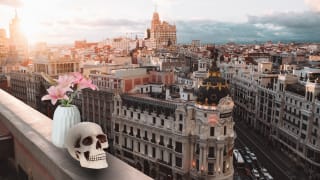Nine ideas to inspire your sustainable place branding strategy
With COP 26 on the horizon, sustainability is perhaps the biggest challenge for place brands. How can you ensure that your strategy delivers against your economic, social, and environmental sustainability ambitions? We reached out to our panel of Experts for their top tips for places looking to authentically embed sustainability at the heart of their place values and strategies…
Develop a holistic approach to avoid ‘greenwashing’
‘Sustainability’ is not a monolith. There are 3 major pillars (environmental, social and economic) and further divisions within these. The strands of sustainability you pursue and emphasise as part of your brand positioning should be driven by the stakeholder groups you have a realistic chance of attracting. Costa Rica has become an eco-tourism hub through ecosystem preservation, Iceland and Denmark have boosted their inward investment appeal by pioneering renewable energy technology, while Brighton has attracted students and knowledge workers through a strong commitment to reducing the city’s environmental footprint. A critical point to remember is that there is a high level of engagement and scepticism around sustainability claims. Consumers and other stakeholders are increasingly aware of ‘greenwashing’, so having (or developing) real substance behind any attempted positioning is key.
Rob Haigh, Strategy & Insight Director, Brand Finance
Shift your strategy to the ‘third level’
In order to truly embed sustainability and be at the forefront of their values and strategies, places need to change the conversation onto a ‘third level’ - a step further than meeting environmental standards and using sustainable technologies such as solar panels. Sustainability is ultimately a far bigger concept than how a place protects the environment, energy and resources. It is also about people and society, and embraces social and economic aspects, such as education, job creation, quality of life and well-being. This is the third level - and opportunity - that places often fall short of fully seizing.
To be truly sustainable, a place brand needs to think and talk about how it impacts and enhances the lives of its citizens and residents in these dimensions, and how it's aiming for a better future in human, not just environmental terms.
Guillaume Cocken, Head of Business Development, Brash
Assess how you can best make an impact
While it is a global problem, it is essential that cities take individual steps toward reducing their carbon footprint. A great first step is to conduct a greenhouse gas emission inventory and from that set actionable goals for reducing that. Simply increasing waste diversion rates can have a huge impact on that.
For it to actually happen cities need to look for ways to ingrain sustainability and climate action not just into long range planning efforts but into the brand and identity of your community.
Ryan Short, CEO and Co-Founder, CivicBrand
Develop a ‘horizontal’ strategy across all your verticals
Sustainability is best incorporated into a place's tourism when it operates as a "horizontal" instead of a "vertical." This means incorporating sustainable tourism in a place's (a) policy, (b) product, and (c) promotion. This allows tourism growth and sustainability to happen symbiotically. For instance, incorporating community-based tourism, sustainable tourism, and movements to develop sustainable certification, standards and training programs for the hospitality sector can allow local, regional or national municipalities to solidify policy. Creating and solidifying an adventure or outdoors tourism product as well as connecting global operators with local operators can help a place incorporate sustainability into its product planning. Lastly, develop a brand campaign focused on expanding across all seasons, interacting with the local culture and heritage, and promoting tours that are environmentally beneficial can allow a destination to not sacrifice sustainability in favor of tourism growth. Moving the needle further on these three Ps will allow places to bounce back from the pandemic with a stronger - economically and environmentally - tourism industry than ever before.
Danny Cohanpour, CEO, Trove Tourism Development Advisors
Actions speak louder than words
As destinations worldwide consider their role and function regarding sustainability, Panama took a bold step forward by rebranding around a sustainable master plan based on the nexus of tourism, conservation, and research. Recognized as truly innovative by UNESCO, the Panama Tourism Master Plan and new brand strategy reaches out to the discerning traveller by focusing on the synergies between conservation efforts and local communities and stakeholders' natural and cultural heritage. Keep your eyes on Panama in 2022!
David Peacock, Senior Advisor to the Future Tourism Group, Simpleview
Let your citizens lead the way
Authenticity is not a brand attribute. Sustainability must lie at the heart of a brand’s values and strategy. Brand-led sustainability requires strong leadership to implement in all the right ways and avoid the risk of ‘green washing’ - which is risky as a brand, let alone a nation. Place brands must first engage the often-overlooked audiences: local citizens, business and hospitality players. Not only do they shape sustainable behaviours, but they provide vision and solutions for companies to adapt to the ever-growing sustainable world around us.
One great example is the incredible culture embedded into Costa Rica; citizens see themselves as genuine guardians of their natural heritage, understanding the importance of protecting their assets and natural environment. They’re exemplar for other countries and will reap the rewards as an eco-friendly destination for many years to come.
Gary Bryant, Executive Director – Strategy, Landor & Fitch
Ask yourself – how will future generations be impacted?
We should all be inspired by the commitment and resilience of Indigenous communities across the globe who have, in many instances, had to fight long, arduous legal, political and cultural battles to be recognized as caretakers and stewards of the places they've inhabited for countless generations. Many Indigenous cultures have a far more sophisticated understanding of our interdependence with nature which is the lifeblood of embedding sustainability at the heart of our places. In order to shoulder our responsibilities to future generations, we have much to learn from First Peoples and their deep appreciation of where we fit in nature’s complexity.
Jeannette Hanna, Chief Strategist, Trajectory
Bring your businesses along on the journey
Our top suggestion would be to make it as easy and as inviting as possible for the consumer and businesses to engage. We have seen this first-hand through our Experience programme in Kent that has helped local businesses to create new, environmentally friendly, innovative and commercially viable tourism products for the UK’s low season such as foraging and cookery; woodland glamping and history and cultural tours.
Deirdre Wells, CEO, Go To Places
Leverage your success to lead the conversation forward
The Dublin Climate Dialogues were held in May this year as a prelude to COP26. Spearheaded by the notion that the forthcoming conference provided an opportunity to "move beyond ambition" and “enact meaningful and binding commitments," the outcome was the Dublin Declaration, for which it was noted that "its precision is the polar opposite to the vague aspiration and voluntary aspect of many climate agreements of the past”
Whilst this was a multilateral prelude, it is significant that it was conceived in Dublin. Sustainability is not empty rhetoric (as it often seems to be)! Dublin was the first city to apply the plastic bag tax, has invested heavily and embraced integrated transport to address the once intractable congestion and pollution problems, and it’s one of the first City Councils to align its Corporate Plan to the SDGs. Dublin is also likely to be one of the first European cities to be powered by renewable energy. It’s high level of tech intensity combined with a strong ethos of social innovation is enabling the City to move beyond planning to test and deploy sustainability solutions in an agile manner.
Judith O’Doherty, Founder, Eutopia Strategy









